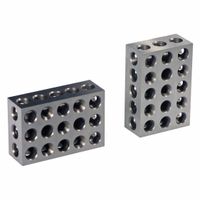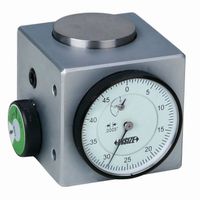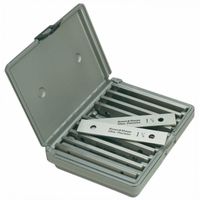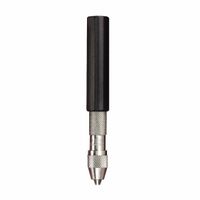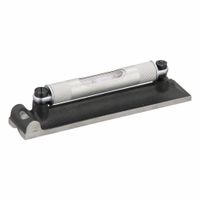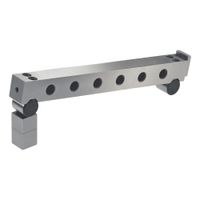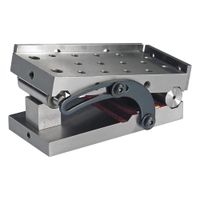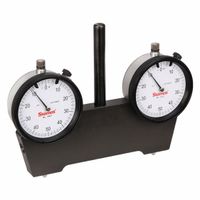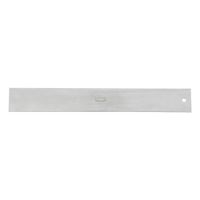Call +(254) 703 030 000 / 751 483 999 / 721 704 777
- Home
- Machining
- Precision Measuring Tools
- Setup Layout Alignment Tools
.....Read More
Frequently Asked Questions
What are 1-2-3 setup blocks used for?
1-2-3 setup blocks are precision tools used primarily in machining and metalworking to aid in the setup and alignment of workpieces on machine tools like mills, lathes, and drill presses. These blocks are named for their dimensions, typically measuring 1 inch by 2 inches by 3 inches, and are made from hardened steel or other durable materials to ensure accuracy and longevity.
The primary uses of 1-2-3 blocks include:
1. **Workpiece Support and Elevation**: They provide a stable and precise platform to elevate workpieces to the desired height, ensuring consistent and accurate machining operations.
2. **Squaring and Alignment**: These blocks are used to square and align workpieces or machine components. Their precise 90-degree angles help in setting up perpendicular or parallel surfaces, ensuring that the workpiece is correctly oriented relative to the machine's axes.
3. **Fixture Construction**: 1-2-3 blocks can be used as components in custom fixtures or jigs. Their precision and uniformity make them ideal for creating repeatable setups, which is crucial for batch production or complex machining tasks.
4. **Measurement and Inspection**: They serve as reference standards for measuring and inspecting parts. Their known dimensions allow machinists to verify the accuracy of other tools or workpieces.
5. **Clamping and Holding**: With threaded holes, 1-2-3 blocks can be used in conjunction with bolts and clamps to secure workpieces or other components during machining, providing a versatile and adaptable clamping solution.
Overall, 1-2-3 setup blocks are essential tools in precision machining, offering versatility and reliability for a wide range of applications.
How do dial and electronic tool setters work?
Dial and electronic tool setters are devices used to ensure precision in machining operations by accurately setting the position of cutting tools relative to the workpiece.
Dial Tool Setters: These are mechanical devices that use a dial indicator to measure the position of a tool. The tool setter is placed on the machine table, and the tool is brought into contact with the setter. The dial indicator, which has a calibrated scale, shows the displacement of the tool. The machinist adjusts the tool position until the desired measurement is achieved. Dial tool setters are valued for their simplicity and reliability, though they require manual reading and adjustment.
Electronic Tool Setters: These are more advanced and use electronic sensors to measure tool position. They can be integrated into CNC machines for automatic tool setting. The tool is brought into contact with the electronic setter, which uses sensors to detect the tool's position. The data is then sent to the machine's control system, which automatically adjusts the tool's position. Electronic setters offer high precision and can compensate for tool wear and thermal expansion. They often feature touch probes or laser systems for non-contact measurement, providing faster and more accurate readings than dial setters.
Both types of tool setters are crucial for maintaining machining accuracy, reducing setup time, and ensuring consistent production quality. Dial setters are more manual and suited for simpler applications, while electronic setters are ideal for complex, high-precision tasks.
What is the purpose of a digital readout (DRO) in machining?
A Digital Readout (DRO) in machining serves as an electronic device that provides precise numerical displays of the position of machine components, typically in milling machines, lathes, and other machine tools. The primary purpose of a DRO is to enhance accuracy, efficiency, and ease of use in machining operations.
1. **Precision and Accuracy**: DROs offer high precision in measuring the position of the machine's moving parts, allowing machinists to achieve exact dimensions and tolerances. This precision is crucial for producing high-quality parts and reducing material waste.
2. **Ease of Use**: By providing a clear digital display of the machine's position, DROs simplify the process of setting up and operating machine tools. This reduces the reliance on manual measurements and calculations, minimizing human error.
3. **Efficiency**: DROs streamline machining operations by allowing for quicker setup times and faster adjustments. Machinists can easily return to specific positions without recalibrating, which speeds up production and increases throughput.
4. **Repeatability**: With DROs, machinists can consistently reproduce parts with the same dimensions, ensuring uniformity in batch production. This repeatability is essential for maintaining quality standards in manufacturing.
5. **Complex Operations**: DROs facilitate complex machining tasks by providing features such as incremental and absolute positioning, hole pattern calculations, and tool compensation. These capabilities enable machinists to perform intricate operations with greater confidence and precision.
6. **User-Friendly Interface**: Modern DROs often come with intuitive interfaces and additional functionalities like memory storage, which allow users to save and recall specific settings or operations, further enhancing productivity.
In summary, the purpose of a DRO in machining is to improve the precision, efficiency, and ease of machining operations, ultimately leading to higher quality products and more efficient manufacturing processes.
How do edge and center finders function?
Edge and center finders are precision tools used in machining to locate the edges or centers of workpieces.
An edge finder typically consists of a shank and a rotating tip. When the machine spindle rotates the edge finder, the tip is slightly offset. As the tool approaches the workpiece, the tip makes contact with the edge, causing it to center itself due to friction. This indicates the precise location of the edge. The machine's digital readout or dial can then be zeroed to establish a reference point.
Center finders, on the other hand, are used to locate the center of a hole or cylindrical workpiece. One common type is the wiggler or wobbler, which has a pointed tip. As the spindle rotates, the tip wobbles until it is perfectly centered in the hole, at which point it stops wobbling. This indicates the center position. Another type is the electronic center finder, which uses a probe and an indicator light or sound to signal when the probe is centered in the hole.
Both tools are essential for ensuring precision in machining operations, allowing for accurate alignment and positioning of the workpiece relative to the cutting tool.
What are parallels used for in machining?
Parallels are precision tools used in machining to ensure accurate and stable workpiece positioning during various operations. They are typically flat, rectangular blocks made from hardened steel, ground to precise dimensions, and often sold in matched pairs. Their primary function is to elevate and support workpieces within a machine vise or on a machine table, ensuring that the workpiece is parallel to the machine's working surface.
In machining, parallels serve several critical purposes:
1. **Elevation**: Parallels raise the workpiece above the vise jaws or machine table, providing clearance for cutting tools and preventing damage to the vise or table during operations like drilling, milling, or grinding.
2. **Alignment**: By providing a flat, level surface, parallels help in aligning the workpiece accurately with the machine's axes. This is crucial for maintaining dimensional accuracy and ensuring that cuts are made at the correct angles and positions.
3. **Stability**: Parallels offer a stable base for the workpiece, reducing vibrations and movement during machining. This stability is essential for achieving precise cuts and maintaining the integrity of the workpiece.
4. **Versatility**: Parallels come in various sizes and thicknesses, allowing machinists to select the appropriate pair for different workpiece dimensions and machining requirements. Adjustable parallels are also available for more customized setups.
5. **Consistency**: Using parallels ensures consistent workpiece positioning across multiple operations or when machining multiple identical parts, contributing to uniformity and repeatability in production.
Overall, parallels are indispensable in machining for enhancing precision, efficiency, and safety, making them a fundamental component in any machinist's toolkit.
How do precision and machinist levels assist in setup?
Precision and machinist levels are essential tools in the setup and alignment of machinery and equipment. They ensure accuracy and efficiency in various industrial and manufacturing processes. Here's how they assist in setup:
1. **Accuracy in Alignment**: Precision levels provide highly accurate measurements of horizontal and vertical planes. This accuracy is crucial for aligning machine components, ensuring that they operate correctly and efficiently.
2. **Reducing Errors**: By using precision levels, machinists can significantly reduce errors in the setup process. This leads to improved product quality and reduces the need for rework, saving time and resources.
3. **Ensuring Stability**: Proper leveling ensures that machines are stable during operation. This stability minimizes vibrations and wear, extending the lifespan of the equipment and maintaining consistent performance.
4. **Facilitating Calibration**: Precision levels are used to calibrate other measuring instruments and tools, ensuring that all equipment is set to the correct specifications. This is vital for maintaining the integrity of the manufacturing process.
5. **Enhancing Safety**: Properly leveled machinery reduces the risk of accidents caused by misalignment or instability. This enhances workplace safety and protects both operators and equipment.
6. **Improving Efficiency**: Well-aligned machines operate more efficiently, reducing energy consumption and increasing productivity. Precision levels help achieve this by ensuring that all components are correctly positioned.
7. **Versatility**: Machinist levels are versatile and can be used in various applications, from setting up lathes and milling machines to aligning large industrial equipment. This versatility makes them indispensable in many settings.
In summary, precision and machinist levels are critical for ensuring the accurate setup and alignment of machinery, leading to improved quality, efficiency, and safety in industrial operations.
What is the role of shaft alignment lasers in machinery setup?
Shaft alignment lasers play a crucial role in the precise setup and maintenance of machinery. They are used to ensure that the shafts of rotating equipment, such as motors, pumps, and compressors, are properly aligned. Proper alignment is essential for the efficient operation of machinery, as misalignment can lead to increased vibration, excessive wear, energy loss, and premature failure of components.
Laser alignment systems provide a high degree of accuracy and repeatability compared to traditional methods like dial indicators or straight edges. They work by projecting a laser beam from a transmitter onto a receiver, which measures the position of the beam. This data is then used to calculate the alignment condition of the shafts, including angular and parallel misalignment.
The use of shaft alignment lasers offers several benefits:
1. **Precision**: Lasers provide highly accurate measurements, often within thousandths of an inch, ensuring optimal alignment.
2. **Efficiency**: The process is faster than manual methods, reducing downtime and labor costs.
3. **Data Analysis**: Modern laser systems often include software that can analyze data, provide alignment corrections, and generate reports for documentation and future reference.
4. **Ease of Use**: Laser systems are user-friendly, often requiring minimal training to operate effectively.
5. **Versatility**: They can be used in various industrial settings and for different types of machinery.
By ensuring proper shaft alignment, laser systems help in extending the lifespan of machinery, improving performance, reducing maintenance costs, and enhancing safety. This makes them an indispensable tool in the setup and ongoing maintenance of industrial equipment.
